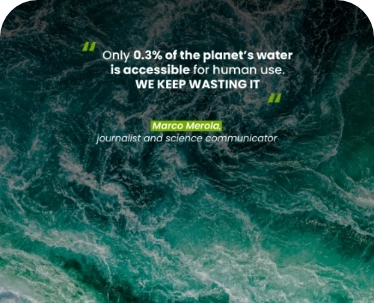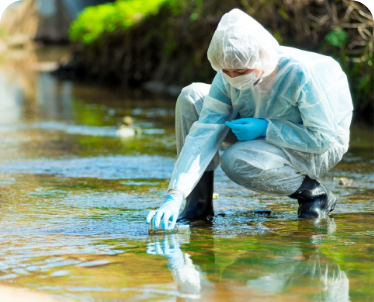There is a small amount of fresh water available on the planet and the population is growing, we must do everything possible to not waste it and learn to regenerate it.
Marco Merola, a science journalist and author of the webdoc, starts from this awareness. Adaptation.it, which in this interview guides us through the challenges and solutions related to sustainable water management. From wastewater management to its reuse in agriculture, through the valorisation of sludge and the recovery of rainwater, Merola tells a concrete path of good practices to address the water emergency with innovation and responsibility. In a context of climate crisis and growing drought like the current one, the challenge is clear: every drop counts.
Water is an increasingly scarce commodity, how important is it to conserve it and not waste it?
Protecting water resources is essential. Water is already a precious resource and, in a world that is estimated to be inhabited by 10 billion people by 2050, it will become increasingly strategic. Currently, 97% of the water on the planet is salty. Only 3% is fresh, but 99% of this is frozen in glaciers or in underground aquifers that are often inaccessible or unsuitable for drinking or agricultural use.
There is only 0.3% of surface water left – that contained in rivers, lakes and ponds – which represents the resource used to satisfy our daily needs. Faced with these numbers and a constantly growing global population, we cannot afford to waste even a drop. It is urgent to invest in all possible solutions to conserve, reuse and regenerate it.
And, in this perspective, what role can the reuse of wastewater play? How can we reuse it and what treatments are necessary to ensure its safe use, which does not compromise the aquifer and public health?
Today, wastewater is mainly used for reintroduction into nature. It is “dirty” water from domestic wastewater, collected through the sewer system and subjected to various treatments before it can be returned to the environment. Its destination is usually natural bodies of water – rivers, streams – or renaturation projects, as in the case of wetlands.
A virtuous example is the WWF oasis on the outskirts of Bologna, a wetland regenerated thanks to the use of treated wastewater, now recolonised by animal species that had disappeared, especially aquatic birds.
The purification process involves several stages. It starts with an initial filtration to remove solid debris – plastic, wood, cotton fioc. Biological treatments follow, in which micro-organisms such as bacteria decompose organic matter. Added to these is anaerobic treatment, based on other bacteria that operate in the absence of oxygen and represent the heart of purification.
The next step is a tertiary filtration, carried out with sand, filter fabrics or membranes, which eliminate the residual particles. Finally, the water passes through activated carbon, which allows any substances still present to be retained.
The water that comes out of this path is purified and can be safely released back into nature, but it is not drinkable.
Is there a European regulation on this matter, or does each member country adopt its own regulations?
In Italy, the regulatory reference point for the reuse of wastewater is Legislative Decree 152 of 1999. This law regulates the types of discharges, defines their characteristics and establishes the concentration limits for the substances present, both in the discharges themselves and in the water once treated. It is a constantly evolving regulatory framework: with the progress of monitoring technologies, new contaminants are being identified, which make it necessary to continuously update the reference parameters. Recently, the so-called “water detectives” – specialised technicians who work for large integrated water cycle utilities – have identified new pollutants never detected in wastewater. Among these, endocrine disruptors stand out, such as bisphenol, and especially PFAS, highly toxic synthetic chemicals, known for their persistence in the environment and for their harmful effects on health. They are the “dark side” of modernity, present everywhere: from non-stick coatings on pans to technical fabrics.
This ever-evolving scenario is described by many as a constantly updated “album of horrors”, which requires those in the sector to remain ever vigilant.
On the regulatory level, something is also moving at the European level, regarding the reuse of purified water in agriculture, one of the most promising solutions to address growing water stress. Italy has already applied the 2020 European Regulation in 2023, but a new EU Directive issued in 2024 is on the way, which must be implemented by 2027. The measure will not only update the existing limits, but will introduce new parameters, with the aim of harmonising and clarifying a regulatory framework that is currently fragmented.
The need to act is urgent: between 2022 and 2023, drought hit Northern Italy hard, while in the following two years, water emergencies were concentrated in the South. In this context, the reuse of wastewater for agricultural use represents a strategic lever to respond to future crises with tools already available.
Does the use of wastewater in agriculture guarantee that crops are not contaminated? Which substances are monitored in agricultural products? Are the analyses carried out sufficient to detect all possible toxic substances that could be absorbed by plants treated with wastewater?
If wastewater is purified in compliance with all the required criteria, it can be said with reasonable certainty that it does not contaminate crops. On this front, CREA – Council for Agricultural Research and Analysis of Agricultural Economics – is particularly active. The objective is to develop targeted planning for the reuse of wastewater, calibrating the level of purification based on the type of crop and the territorial context.
In fact, a real “matching” between the chemical biological characteristics of the treated water and the needs of the different crops is needed, so that the agricultural use of wastewater is not only safe, but also effective from an agronomic and environmental point of view.
Not all purified water is suitable for all crops: this is a fundamental point that needs to be clarified. Domestic wastewater, that is, that which comes out of our homes, naturally contains high concentrations of phosphorus and nitrogen, two essential elements for soil fertility and plant development.
These same nutrients are often added artificially through chemical fertilisers, with harmful side effects in the long term, such as soil impoverishment. Instead, using wastewater already rich in phosphorus and nitrogen represents a concrete opportunity for more sustainable agriculture.
According to some studies, if well purified and used correctly, wastewater could cover up to 70% of the water needs of agricultural fields, while offering a natural supply of nutrients.
Today, analyses can detect a wide range of potentially toxic substances, but monitoring must be constantly updated: the presence of heavy metals, for example, must be excluded to avoid contamination along the growth cycle of plants and in fruits intended for human consumption.
A virtuous example is the project promoted by ENEA in collaboration with HERA, a utility of Emilia-Romagna also active in other Italian regions, documented in the webdoc Adaptation. The initiative demonstrates how the targeted use of wastewater can become a valuable resource for the agriculture of the future.
A small experimental greenhouse fed with purified wastewater has been built in the Cesena purification plant: a pilot project for growing tomatoes and peaches. The results have been surprising. The plants are growing luxuriantly and there has been a significant increase in production, thanks to the high natural concentration of phosphorus and nitrogen present in the treated water.
According to a report by Greenreport, over 10 million tonnes of sewage sludge are produced annually in Europe. This sludge can be used as fertiliser in agriculture, but under what conditions?
Sewage sludge is an important resource to be exploited, especially at a time when it is urgent to regenerate the land while minimising the use of chemical substances. This is the final residue that collects in the sedimentation basins of plants that treat wastewater from domestic, industrial or mixed settlements.
Once deposited, the sludge is separated from the water cycle and directed towards a specific treatment line. If managed correctly, it can play a fundamental role in agriculture. One of the most widespread practices is controlled spreading on agricultural soils, which allows the fertilising value of the sludge to be recovered thanks to the natural presence of substances such as nitrogen, phosphorus and potassium.
With Adaptation, we documented a good practice started in Veneto by an integrated water cycle company: here, sludge is treated and sent to cultivated fields, while reducing the use of chemical fertilisers and the volume of waste sent to landfill. It is an approach also supported by a European regulation that promotes the agricultural use of sludge to avoid more impactful forms of disposal, such as burning or burial.
But even more can be done. In Veneto, for example, they are experimenting with the creation of deposits of already purified sludge, continuously mixed by automated systems and dehydrated in temperature-controlled environments. This allows not only to make them inert, but also to reduce their weight and volume, cutting costs and emissions related to transportation. A model of circular economy that demonstrates how sludge management can become an environmental and economic opportunity.
What are the risks of contamination of plants by heavy metals or other pollutants present in sludge?
In sludge, persistent organic pollutants, endocrine disruptors, heavy metals or pharmaceutical substances can be found. Many cases of reuse of toxic sludge have involved Northern Italy, especially Lombardy. There are plants that tolerate heavy metals better, such as turnips and cabbages, but the others all have a common fate.
Do you not think that a more careful management of rainwater, through retention systems rather than accelerating its flow towards the sea, could lead to more reliable results in terms of reducing potential pollution, protecting human health and safeguarding biodiversity?
Yes. A more careful management of rainwater is essential. Today, unfortunately, in many Italian cities rainwater still flows into the same drainage channels used for the so-called black water, that is, water coming from urban sewage. This is a major limitation. In fact, there are very few places in Italy where there are separate drainage networks for rainwater and wastewater.
Yet, if we could adapt cities to collect and contain rainwater – for example through storage tanks – we would gain a huge advantage. In Italy it rains a lot: it is estimated that there is about 500 billion cubic metres of water available per year, yet we retain a minimal percentage of it. The problem is not so much to make the water flow quickly to avoid flooding, but to retain it intelligently.
A virtuous example is that of Rimini. Under Piazzale Kennedy, two large capacity underground tanks have been built. When it rains heavily, these tanks collect the so-called “first rainwater”, preventing the city from flooding. From there, the water is sent to the purifier. The issue of discharge into the sea has also been addressed: previously, excess rainwater ended up directly on the beach; today, only the water that the tanks cannot retain is expelled into the sea, while the rest is reintroduced into the cycle. This is an important change.
As far as biodiversity is concerned, there are no real risks related to rainwater itself. In fact, it mainly carries pollen, atmospheric particulate matter and, rarely, pathogens. The real danger for ecosystems is represented by the pollution of rivers and waterways, caused by new and toxic substances detected in environmental monitoring.
Some signs of adaptation come from nature itself: macroinvertebrates such as insect larvae are modifying their physiology to survive in altered environments. But we must do everything we can to not exceed the so-called tipping point, the point of no return, beyond which nature will no longer be able to react. And if we reached that limit, it would mean that we have asked too much of a system already under stress.



